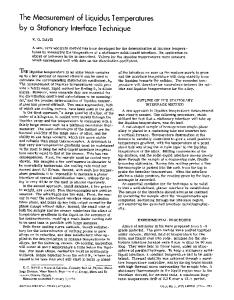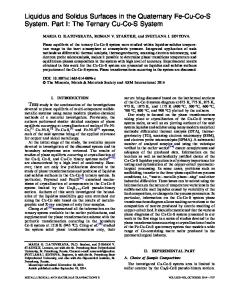Liquidus temperatures in the Ti-Al system
- PDF / 755,703 Bytes
- 6 Pages / 597 x 774 pts Page_size
- 91 Downloads / 430 Views
I.
INTRODUCTION
Two recently proposed titanium-aluminum binary phase diagram revisions exhibit important uncertainties that result from inaccurate liquidus temperature measurements, tl,21 For example, liquidus temperature data reported by different investigators span a range of 50 K in the near-equiatomic region of the diagram) 3,4,51 The characteristics of the Ti-A1 system which have led to these uncertainties include reactions with containers and gaseous impurities, compositional shifts due to loss of the more volatile aluminum component, rapid solid-state phase transformations, and ambiguities in the room-temperature microstructures. As a result, the equilibrium phase diagram is still not completely understood even though many investigations of this system have been reported. ~H~] The present research used containerless experimental techniques to determine accurate liquidus temperatures at near-equiatomic compositions in the titanium-aluminum system. These liquidus measurements were made possible by separate polarimetric measurements of liquid optical properties, tt2J which allowed accurate correction of apparent temperatures measured with optical pyrometry. The results agree with previous results reported by Ogden et al. I3] and Kornilov et al. t51 but are in poor agreement with the liquidus data of Bumps et al. t4~ and the liquidus curves used in two recent versions of the Ti-A1 phase diagrams. 1~,2] II.
A . E l e c t r o m a g n e t i c Levitation P r o c e s s i n g
The experiments were conducted in an apparatus described by Bertero et al. ~133 The system was first evacuated to less than 5 • 10 -5 tort (7 • 10 -3 Pa) and filled to about one-half an atmosphere (5 • 104 Pa) with coldtrapped, ultrahigh-purity (UHP) helium gas. Then a specimen was levitated, melted, heated above the melting point to clean the sample surface, and cooled with flowing UHP helium under a constant ambient pressure. The gas flow rate was adjusted to stabilize the apparent temperature, and nucleation was attempted by touching the sample with a pyrex whisker. If the sample was above the liquidus temperature, nucleation of the solid was thermodynamically impossible and did not occur, thereby providing an upper bound to the liquidus temperature. In such cases, the apparent temperature was reduced and the process repeated until nucleation occurred at some minimal undercooling, as indicated by the resulting small recalescence peak. The apparent liquidus temperature was then determined from the recalescence peak temperature and correlated with thermal arrest data obtained during melting. B. N o n c o n t a c t Temperature M e a s u r e m e n t
The liquidus determinations in this work rely on noncontact temperature measurement techniques. A detailed description of the pyrometry calibration and measurement procedures is provided in the Appendix.
EXPERIMENTAL
Specimens prepared from arc-cast ingots were levitated and melted inductively under an inert helium atmosphere. The apparent temperatures of the levitated liquid specimens were meas
Data Loading...











